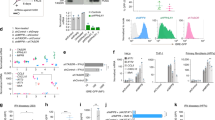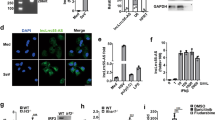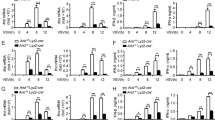Abstract
Inappropriate stimulation or defective negative regulation of the type I interferon response can lead to autoinflammation. In genetically uncharacterized cases of the type I interferonopathy Aicardi–Goutières syndrome, we identified biallelic mutations in LSM11 and RNU7-1, which encode components of the replication-dependent histone pre-mRNA–processing complex. Mutations were associated with the misprocessing of canonical histone transcripts and a disturbance of linker histone stoichiometry. Additionally, we observed an altered distribution of nuclear cyclic guanosine monophosphate–adenosine monophosphate synthase (cGAS) and enhanced interferon signaling mediated by the cGAS–stimulator of interferon genes (STING) pathway in patient-derived fibroblasts. Finally, we established that chromatin without linker histone stimulates cyclic guanosine monophosphate–adenosine monophosphate (cGAMP) production in vitro more efficiently. We conclude that nuclear histones, as key constituents of chromatin, are essential in suppressing the immunogenicity of self-DNA.
This is a preview of subscription content, access via your institution
Access options
Access Nature and 54 other Nature Portfolio journals
Get Nature+, our best-value online-access subscription
$29.99 / 30 days
cancel any time
Subscribe to this journal
Receive 12 print issues and online access
$209.00 per year
only $17.42 per issue
Buy this article
- Purchase on Springer Link
- Instant access to full article PDF
Prices may be subject to local taxes which are calculated during checkout






Similar content being viewed by others
Data availability
The RNA-seq data have been deposited at the National Center for Biotechnology Information Gene Expression Omnibus (accession no. GSE153079). The exome and genome sequencing data are not publicly available due to the possibility of compromising privacy. Human fibroblasts are primary cells and therefore a limited resource. Availability is through the corresponding author subject to technical constraints and completion of a material transfer agreement required to ensure patient privacy.
References
Roers, A., Hiller, B. & Hornung, V. Recognition of endogenous nucleic acids by the innate immune system. Immunity 44, 739–754 (2016).
Uggenti, C., Lepelley, A. & Crow, Y. J. Self-awareness: nucleic acid-driven inflammation and the type I interferonopathies. Annu. Rev. Immunol. 37, 247–267 (2019).
Bartsch, K. et al. Absence of RNase H2 triggers generation of immunogenic micronuclei removed by autophagy. Hum. Mol. Genet. 26, 3960–3972 (2017).
Harding, S. M. et al. Mitotic progression following DNA damage enables pattern recognition within micronuclei. Nature 548, 466–470 (2017).
Mackenzie, K. J. et al. cGAS surveillance of micronuclei links genome instability to innate immunity. Nature 548, 461–465 (2017).
Gentili, M. et al. The N-terminal domain of cGAS determines preferential association with centromeric DNA and innate immune activation in the nucleus. Cell Rep. 26, 3798 (2019).
Yang, H., Wang, H., Ren, J., Chen, Q. & Chen, Z. J. cGAS is essential for cellular senescence. Proc. Natl Acad. Sci. USA 114, E4612–E4620 (2017).
Zierhut, C. et al. The cytoplasmic DNA sensor cGAS promotes mitotic cell death. Cell 178, 302–315.e23 (2019).
Denais, C. M. et al. Nuclear envelope rupture and repair during cancer cell migration. Science 352, 353–358 (2016).
Raab, M. et al. ESCRT III repairs nuclear envelope ruptures during cell migration to limit DNA damage and cell death. Science 352, 359–362 (2016).
Jiang, H. et al. Chromatin-bound cGAS is an inhibitor of DNA repair and hence accelerates genome destabilization and cell death. EMBO J. 38, e102718 (2019).
Lahaye, X. et al. NONO detects the nuclear HIV capsid to promote cGAS-mediated innate immune activation. Cell 175, 488–501.e22 (2018).
Liu, H. et al. Nuclear cGAS suppresses DNA repair and promotes tumorigenesis. Nature 563, 131–136 (2018).
Volkman, H. E., Cambier, S., Gray, E. E. & Stetson, D. B. Tight nuclear tethering of cGAS is essential for preventing autoreactivity. eLife 8, e47491 (2019).
Crow, Y. J. et al. Mutations in the gene encoding the 3′-5′ DNA exonuclease TREX1 cause Aicardi–Goutières syndrome at the AGS1 locus. Nat. Genet. 38, 917–920 (2006).
Crow, Y. J. et al. Mutations in genes encoding ribonuclease H2 subunits cause Aicardi–Goutières syndrome and mimic congenital viral brain infection. Nat. Genet. 38, 910–916 (2006).
Rice, G. I. et al. Mutations involved in Aicardi–Goutières syndrome implicate SAMHD1 as regulator of the innate immune response. Nat. Genet. 41, 829–832 (2009).
Rice, G. I. et al. Mutations in ADAR1 cause Aicardi–Goutières syndrome associated with a type I interferon signature. Nat. Genet. 44, 1243–1248 (2012).
Rice, G. I. et al. Gain-of-function mutations in IFIH1 cause a spectrum of human disease phenotypes associated with upregulated type I interferon signaling. Nat. Genet. 46, 503–509 (2014).
Crow, Y. J. & Manel, N. Aicardi–Goutières syndrome and the type I interferonopathies. Nat. Rev. Immunol. 15, 429–440 (2015).
Pillai, R. S. et al. Unique Sm core structure of U7 snRNPs: assembly by a specialized SMN complex and the role of a new component, Lsm11, in histone RNA processing. Genes Dev. 17, 2321–2333 (2003).
Kolev, N. G. & Steitz, J. A. In vivo assembly of functional U7 snRNP requires RNA backbone flexibility within the Sm-binding site. Nat. Struct. Mol. Biol. 13, 347–353 (2006).
Badrock, A. P. et al. Analysis of U8 snoRNA variants in zebrafish reveals how bi-allelic variants cause leukoencephalopathy with calcifications and cysts. Am. J. Hum. Genet. 106, 694–706 (2020).
Marzluff, W. F., Wagner, E. J. & Duronio, R. J. Metabolism and regulation of canonical histone mRNAs: life without a poly(A) tail. Nat. Rev. Genet. 9, 843–854 (2008).
Müller, B. & Schümperli, D. The U7 snRNP and the hairpin binding protein: key players in histone mRNA metabolism. Semin. Cell Dev. Biol. 8, 567–576 (1997).
Dominski, Z. & Marzluff, W. F. Formation of the 3′ end of histone mRNA: getting closer to the end. Gene 396, 373–390 (2007).
Wang, Z. F., Whitfield, M. L., Ingledue, T. I.3rd, Dominski, Z. & Marzluff, W. F. The protein which binds the 3′ end of histone mRNA: a novel RNA- binding protein required for histone pre-mRNA processing. Genes Dev. 10, 3028–3040 (1996).
Martin, F., Schaller, A., Eglite, S., Schümperli, D. & Müller, B. The gene for histone RNA hairpin binding protein is located on human chromosome 4 and encodes a novel type of RNA binding protein. EMBO J. 16, 769–778 (1997).
Sabath, I. et al. 3′-End processing of histone pre-mRNAs in Drosophila: U7 snRNP is associated with FLASH and polyadenylation factors. RNA 19, 1726–1744 (2013).
Sullivan, E. et al. Drosophila stem loop binding protein coordinates accumulation of mature histone mRNA with cell cycle progression. Genes Dev. 15, 173–187 (2001).
Marzluff, W. F., Gongidi, P., Woods, K. R., Jin, J. & Maltais, L. J. The human and mouse replication-dependent histone genes. Genomics 80, 487–498 (2002).
Rice, G. I. et al. Assessment of interferon-related biomarkers in Aicardi–Goutières syndrome associated with mutations in TREX1, RNASEH2A, RNASEH2B, RNASEH2C, SAMHD1, and ADAR: a case-control study. Lancet Neurol. 12, 1159–1169 (2013).
Chen, Q., Sun, L. & Chen, Z. J. Regulation and function of the cGAS–STING pathway of cytosolic DNA sensing. Nat. Immunol. 17, 1142–1149 (2016).
Streicher, F. & Jouvenet, N. Stimulation of innate immunity by host and viral RNAs. Trends Immunol. 40, 1134–1148 (2019).
Izquierdo-Bouldstridge, A. et al. Histone H1 depletion triggers an interferon response in cancer cells via activation of heterochromatic repeats. Nucleic Acids Res. 45, 11622–11642 (2017).
Lepelley, A. et al. Mutations in COPA lead to abnormal trafficking of STING to the Golgi and interferon signaling. J. Exp. Med. 217, e20200600 (2020).
Gilbert, N. et al. Formation of facultative heterochromatin in the absence of HP1. EMBO J. 22, 5540–5550 (2003).
Gilbert, N. et al. DNA methylation affects nuclear organization, histone modifications, and linker histone binding but not chromatin compaction. J. Cell Biol. 177, 401–411 (2007).
Cook, A. J., Gurard-Levin, Z. A., Vassias, I. & Almouzni, G. A specific function for the histone chaperone NASP to fine-tune a reservoir of soluble H3-H4 in the histone supply chain. Mol. Cell 44, 918–927 (2011).
Peterson, C. L. & Hansen, J. C. Chicken erythrocyte histone octamer preparation. CSH Protoc. 2008, pdb.prot5112 (2008).
Allan, J., Staynov, D. Z. & Gould, H. Reversible dissociation of linker histone from chromatin with preservation of internucleosomal repeat. Proc. Natl Acad. Sci. USA 77, 885–889 (1980).
Yang, L., Duff, M. O., Graveley, B. R., Carmichael, G. G. & Chen, L.-L. Genomewide characterization of non-polyadenylated RNAs. Genome Biol. 12, R16 (2011).
Flicek, P. et al. Ensembl 2014. Nucleic Acids Res. 42, D749–D755 (2014).
Kim, D., Langmead, B. & Salzberg, S. L. HISAT: a fast spliced aligner with low memory requirements. Nat. Methods 12, 357–360 (2015).
Li, H. et al. The Sequence Alignment/Map format and SAMtools. Bioinformatics 25, 2078–2079 (2009).
Quinlan, A. R. & Hall, I. M. BEDTools: a flexible suite of utilities for comparing genomic features. Bioinformatics 26, 841–842 (2010).
Kent, W. J. et al. The human genome browser at UCSC. Genome Res. 12, 996–1006 (2002).
Love, M. I., Huber, W. & Anders, S. Moderated estimation of fold change and dispersion for RNA-seq data with DESeq2. Genome Biol. 15, 550 (2014).
Acknowledgements
We thank W. Bickmore, F. Taglini, P. Heyn, T. Chandra, R. O’Keefe, Z. Dominski, W. Marzluff, L. Murphy, L. Sanchez-Pulido and C. Ponting for help and advice. We acknowledge the help of the Genetics Core, Edinburgh Clinical Research Facility, University of Edinburgh. Y.J.C. acknowledges the European Research Council (grant nos. GA309449 and 786142-E-T1IFNs), a state subsidy managed by the National Research Agency (France) under the ‘Investments for the Future’ program bearing (no. ANR-10-IAHU-01) and the National Institute for Health Research UK Rare Genetic Disease Research Consortium. The project was supported by MSDAVENIR (Devo-Decode Project) and the Fondation Maladies Rare (GenOmics of rare diseases 2016-1). N.G., D.S., J.L.G.-P., A.P.J. and M.A.M.R. are supported by a UK Medical Research Council (MRC) Human Genetics Unit core grant (no. U127580972). D.S. is a Cancer Research UK Career Development fellow (no. C47648/A20837). This work was supported by a Chancellor’s fellowship of the University of Edinburgh and an Institutional Strategic Research Fund (ISSF3) to A. Dhir. J.R. is supported by the MRC (core funding of the MRC Human Immunology Unit). J.H. was supported by the European Commission under the Horizon 2020 program. We acknowledge the Edinburgh Super-Resolution Imaging Consortium, supported by the Wellcome Trust (grant no. 208345/Z/17/Z).
Author information
Authors and Affiliations
Contributions
C.U., A.L., M.D., A.P.B., M.P.R., M.-T.E.-D., G.I.R., A.P.W., A. Dhir, W.A., M.-L.F., L.S., J.D., N.B., M.J.M.-N., E.D.M., D.S., J.R., J.H., M.A.M.R. and N.G. performed the experiments. S.D., A.R.-R. and J.L.G.-P. performed the bioinformatic analyses. J.-F.D., A.B-A. and R.O. were responsible for genome sequencing. J. Baruteau, K.B., J. Buckley, V.C., C.C., L.M.H.D.W., A. Dobbie, D.D., F.E., M.K.-H., R.K., K.L., J.H.L., A.M., C.M.L., S.O., S.P., K.R., C.A.S., C.S., D.T., G.T., M. Valente, H.V.D.L., H.V.E., M. Vermelle and K.W. ascertained and diagnosed the clinical cases. C.U., A.P.J., M.A.M.R., N.G. and Y.J.C. wrote and edited the manuscript. Y.J.C. was responsible for the overall supervision of the project.
Corresponding author
Ethics declarations
Competing interests
The authors declare no competing interests.
Additional information
Publisher’s note Springer Nature remains neutral with regard to jurisdictional claims in published maps and institutional affiliations.
Extended data
Extended Data Fig. 1 RNU7-1 sequence variants and pedigrees.
a, CLUSTAL Omega alignment of RNU7-1 sequences. Single nucleotide substitutions identified in probands with Aicardi-Goutières syndrome shaded individually for ease of visualization. Human NR_023317.1 ENSG00000238923; Orangutan U7 ENSPPYG00000029105; Horse U7 ENSECAG00000027042; Chicken U7 ENSGALG00000025670; Anole U7 ENSACAG00000019795; Zebrafish CR388102.4 ENSDARG00000082384; Tetraodon U7 ENSTNIG00000020484; Xenopus U7-201 ENSXETT00000102447.1; Drosophila snRNA:U7 FBgn0053504. b, Structure of pedigrees in which individuals with an Aicardi-Goutières syndrome phenotype were recorded to harbor biallelic rare (allelic frequency ≤ 0.005 on gnomAD) variants in RNU7-1 encoding the snRNA U7. nt, not tested. Variants in grey (n.59C>T and n.62C>G) have a frequency < 0.005 but are considered likely non-pathogenic on the basis of familial segregation.
Extended Data Fig. 2 LSM11 knockdown and RDH pre-mRNA expression in fibroblasts.
a,b, The effect of knockdown of LSM11 in HCT116 (a) and U2OS (b) cells on the processing of replication-dependent histone mRNAs. Primers surrounding the cleavage site were used to assess the presence of polyadenylated RDH transcripts after 24 h knockdown of LSM11 by siRNA. Error bars indicate standard deviation from the mean. Two-tailed Mann-Whitney U test was used to compare differences between two groups. Experiments were performed with a minimum of 3 technical replicates. c, Misprocessing of RDH mRNAs in fibroblasts. Bar charts showing the expression of polyadenylated (Poly(A)+) and non-polyadenylated (Poly(A)-) replication dependent linker (H1) or core (H2A, H2B, H3, H4) histone transcripts in control (n = 3) and AGS8/9 patient-derived (n = 3) fibroblasts.
Extended Data Fig. 3 Interferon signaling in patient blood.
Relative quantification (RQ) values of a panel of six interferon-stimulated genes (ISGs) measured in whole blood in 12 AGS families (AGS114 mutated in LSM11; all others mutated in RNU7-1), compared to the combined results of 29 healthy controls. Numbers in brackets refer to decimalized age at sampling, followed by an interferon score calculated from the median fold change in relative quantification value for the panel of six ISGs. Shades denote individuals, with repeat samples indicated by different bars of the same shade.
Extended Data Fig. 4 ISGs expression and treatment with BX795 and ruxolitinib in patient-derived fibroblasts.
a, Gene set enrichment analysis (GSEA) of genome-wide RNA-seq data derived from control (n = 3) and patient-derived (n = 3) fibroblasts. P value is estimated using GSEA empirical phenotype-based permutation test. b, Treatment of patient fibroblasts with BX795 and ruxolitinib. Assessment of IFIT1 expression following treatment of patient fibroblasts with the TBK1 chemical inhibitor BX795, and the JAK1/2 inhibitor ruxolitinib. Kruskal-Wallis H test, followed by Dunn’s multiple comparison test. Experiments were performed with a minimum of 3 technical replicates. Box plots show the minimum and maximum scores (bottom and top whisker respectively) outside the interquartile range, the lower quartile, the median, and the upper quartile. Data points in the box plots represent the average value per cell line for each experiment.
Extended Data Fig. 5 ISG expression in THP-1 cells after LSM11 knockdown.
a, Expression of interferon beta and selected interferon stimulated genes (ISGs) following 4 to 5 days LSM11 lentivirus shRNA transduction of THP-1 cells. b,c, Expression of interferon beta and selected ISGs (b) and of ISG15 protein (c) following LSM11 lentivirus shRNA transduction of THP-1 cells wild-type or null for cGAS, STING or MAVS. Cofilin was used as a housekeeping protein. The white asterisk indicates a non-specific band. Box plots show the minimum and maximum scores (bottom and top whisker, respectively) outside the interquartile range, the lower quartile, the median, and the upper quartile. Data points in the box plots represent the value for each experiment. Differences in expression within groups were assessed by Kruskal-Wallis H test, followed by Dunn’s multiple comparison test. Error bars indicate standard deviation. Experiments were performed with a minimum of 3 technical replicates.
Extended Data Fig. 6 ISG and phospho-STING expression in THP-1 cells after LSM11 knockdown.
a, Full blot corresponding to Fig. 5e. b, Expression of phospho-STING (Ser366) following knockdown of LSM1 in THP-1 cells wild-type or null for cGAS, STING or MAVS. Vinculin was used as a housekeeping protein. The black arrows indicate the band corresponding to phospho-STING. Experiments were performed with a minimum of 3 biological and/or technical replicates.
Extended Data Fig. 7 Knockdown of nucleic acid sensing pathway molecules in fibroblasts.
a, Knockdown efficiency of MYD88, and expression of ISG15 following MYD88 downregulation. b, Knockdown efficiency of STING, cGAS, MYD88 or MAVS corresponding to Fig. 5f. Two-tailed Mann-Whitney U test was used to compare differences between two groups.
Extended Data Fig. 8 ISG expression in fibroblasts following knockdown of nucleic acid sensing pathway molecules in two different patient lines.
a, AGS8. b, AGS9 (full blot corresponding to Fig. 5f). Experiments were performed with a minimum of 3 biological and/or technical replicates. Vertical white dotted line in a and b (left panel) indicates where gel was cropped.
Extended Data Fig. 9 Assessment of histone protein levels in control and AGS patient fibroblasts.
a, Coomassie blue gel of fibroblast nuclear extract in control (C) and patient (AGS) fibroblasts, and in HEK293 cells. Bands corresponding to linker histones (H1) and core histones (H2A, H2B, H3 and H4) are indicated. The bottom panel shows the same samples run with higher amount of nuclear extract. n = 2 biologically independent samples of control and/or patient fibroblasts. b, Western blot of chromatin-bound histones using antibodies specific to H1.2 and H1.4. Full blot corresponding to Fig. 6b showing that samples were loaded on the same gel.
Extended Data Fig. 10 Proposed model explaining the induction of interferon signaling secondary to mutations in LSM11 or RNU7-1 (AGS8/9).
The U7 snRNP complex is essential for the processing of RDH pre-mRNAs in histone locus bodies (HLB). Mutations in LSM11 and RNU7-1 result in disturbed histone stoichiometry (perhaps particularly relating to linker histones), leading to increased binding of cGAS (green dots) to nuclear DNA and/or enhanced cGAS activation, and the subsequent induction of interferon signaling.
Supplementary information
Supplementary Information
Supplementary Figs. 1 and 2 and Tables 1–9
Rights and permissions
About this article
Cite this article
Uggenti, C., Lepelley, A., Depp, M. et al. cGAS-mediated induction of type I interferon due to inborn errors of histone pre-mRNA processing. Nat Genet 52, 1364–1372 (2020). https://doi.org/10.1038/s41588-020-00737-3
Received:
Accepted:
Published:
Issue Date:
DOI: https://doi.org/10.1038/s41588-020-00737-3
This article is cited by
-
Preimplantation genetic testing for Aicardi–Goutières syndrome induced by novel compound heterozygous mutations of TREX1: an unaffected live birth
Molecular Cytogenetics (2023)
-
A case of Aicardi-Goutières syndrome caused by TREX1 gene mutation
BMC Pregnancy and Childbirth (2023)
-
RBP–RNA interactions in the control of autoimmunity and autoinflammation
Cell Research (2023)
-
Clinical spectrum and currently available treatment of type I interferonopathy Aicardi–Goutières syndrome
World Journal of Pediatrics (2023)
-
Organellar homeostasis and innate immune sensing
Nature Reviews Immunology (2022)



